|
|
Americans today generally view the history of the Great Irish Potato Famine (1845+) through cultural lenses which tend to distort the realities of history as often as they magnify elements of truth. These lenses develop as a result of the normal processes of folk oral traditional transmission but are also imposed by political organizations with axes to grind. It is important while examining the history of the Famine to begin with the facts and only once the facts have been revealed move to enjoy the folk oral tradition which has developed around it and then to the respect for the suffering brought by the tragedy. We must do this because the lessons of the Famine have not yet been learned. The 20th century has seen little if any progress toward the elimination of famine from the human condition. We cannot allow the tears nor the methods and causes of politics to obscure the facts and prevent change and the learning of the lessons of this tragedy.
Up until this time the Irish people were dependent not only upon the potato as a source of food and income but upon the purchase of other foodstuffs which they produced including a most important one--wheat. The purchase of great quantities of Irish agricultural produce by England helped the Irish economy to grow and the people to prosper. The excessive demand created by the English war efforts distorted the Irish economy. When the major European wars came to an end, England reduced dramatically its investment in Irish agricultural products. Ireland received great prosperity from the English.
1800 population 5.0 million 1821 population 6.5 million 1841 population 8.0 million
The dependence of the Irish upon the potato helped greater numbers to survive. Potatoes which could feed many could be grown on small plots and not detract from the payments due the landlord for cash crops. However, none of this growth would have been possible without the presence of a thriving economy--potato or no potato--and the prosperity which brought growth was provided by England.
England was a valuable trading partner--even if a politically dominant one. With the end of a boom, however, comes a bust and unemployment was the result. It is the backdrop for the famine and a primary underlying foundation for the events and suffering which occurred.
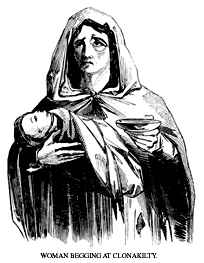 "'I started from Cork
for Skibbereen "'I started from Cork
for Skibbereen and saw little until we came to Clonakilty, where . . . the horrors of the poverty became visible, in the vast number of famished poor, who flocked around the coach to beg alms: amongst them was a woman carrying in her arms the corpse of a fine child, and making the most distressing appeal to the passengers for aid to enable her to purchase a coffin and bury her dear little baby. This horrible spectacle induced me to make some inquiry about her, when I learned from the people of the hotel that each day brings dozens of such applicants into the town." |
Two-thirds of the Irish were dependent upon Agriculture as a source of income. The remaining one-third engaged in other industrial and economic pursuits did not fare well in competition against a developing English manufacturing and industrial economy. Business was lost. While England was indeed a major economic force, a great burden for the failure of the Irish economy to grow outside of Agriculture has been associated with the ways in which the Irish as a Culture adapted to the new industrial economy--the ways in which businesses were established and the inability of local groups and organizations to pool resources to foster economic growth (especially in the Fishing industry). These problems are seen by economists not to have been caused by the dominance of England but by the choices of the Irish informed by cultural tendencies and practices. Successful economic strategies, products and markets were not developed.
Famine noted in the Irish press for the first time on September 9. Sir Robert Peel, Prime Minister of England, took prompt action:
Peel's government confronted a disaster the likes of which had never occurred in Europe. Economic depression as well as the Famine combined with economic re-alignment, changes in agricultural technology, and the rise of industry. The reaction of the English government was not unlike the reaction of FDR during America's depression era. Rather than hand out money and food, it was thought by the best minds of the day in England best to put people to work. The debate over the concept of public welfare is still raging in our country and throughout the world today. Then as now many believed that feeding the poor would produce greater numbers of hungry and compound the situation by creating the welfare dependent masses, ruining the work ethic. The government also did not want to totally close down the Irish agricultural economy (putting many more out of work to starve) by stopping the export of food. This point is often brought up in discussions of the Famine:How could the English continue exports of Irish food during the famine?
There was a very good case made that should agricultural production for cash be shut down, the English would be hurting those that they were trying to help. (One should not miss here the similarity of the recent situation in South Africa. The U.S. discouraged boycott so that African workers would continue to be employed and the country could remain stable to bring about reforms in an orderly way.) The English Government hoped that through the application of funds and aid received from English taxpayers that the needs of the Irish people could be met. However, the disaster was far too large and complex.
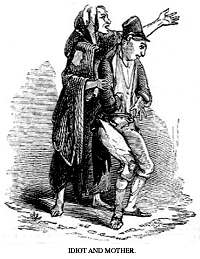 "The wretched mendicant,
with her idiot boy, is an object of deep commiseration. The poorest wretch
to whom his mother appeals in his behalf would be almost afraid, in the
sight of Heaven, to refuse to divide a handful of meal or potatoes with
him. From morning till night his eternal 'pal, la! pal la!' is heard, unless
when he stops the cravings of hunger with the offals that are thrown to
him by the hand of poverty-stricken charity." "The wretched mendicant,
with her idiot boy, is an object of deep commiseration. The poorest wretch
to whom his mother appeals in his behalf would be almost afraid, in the
sight of Heaven, to refuse to divide a handful of meal or potatoes with
him. From morning till night his eternal 'pal, la! pal la!' is heard, unless
when he stops the cravings of hunger with the offals that are thrown to
him by the hand of poverty-stricken charity." |
When we read of the actions of the men of the day, let us remember that England at that time was the culture and society written about by Charles Dickens with all of the flaws which he described in his novels. Often as we look back upon historical events we people the world with ideal human beings designed complete with our own morality and cultural values. (Sometimes also we populate the world with humans who are designed as demons!) To ask for a man dedicated to modern concepts of human rights to stand up within the ruling classes of the world at that time would be the equivalent of asking the contemporary Irish peasant to turn on a light bulb to illuminate his or her cottage; they simply had not been invented yet, at least in any great numbers. In fact, the Famine would lead to the generation of modern relief methods and practices and their implementation for the first time. Bear in mind also that conditions in the USA were also not that wonderful. In 1845 slavery was still with Americans as was the cruel opening of the flowers of the industrial revolution which consumed their human workers, both immigrant and native alike, as Venus fly traps made of factory machines.
Under the new government an economic philosophy called laissez-faire dominated the thinking of politicians and economists who desired to manage the economy. Still today, our own world economy is managed by economic gurus in the United States Federal Reserve working not from a concrete and exacting science but from a philosophy which just happens to work from time to time. [To clarify, the laissez-faire philosophy is not the one which guides U.S. Federal Reserve actions today. Nevertheless, there is an economic philosophy which guides its actions, as the laissez-faire philosophy did in Britain in the early 19th century.--ed.] Laissez-Faire as a philosophy called for non-intervention by government in the economy and held that it was wrong for the government to meddle in economics at all. Charles Wood believed this strongly and he was the Chancellor of the Exchequer under the new Russell Government. Charles Trevelyan was the head of treasury--a permanent position--and he agreed. It is not that the government did not try to solve the Famine but that the economic theory (the specific cure selected) failed, as did the crop and the economy and the future plans of agricultural development. Government funding for aid and purchase of food was discontinued and the responsibility for aid placed into the hands of private enterprise. (Note the similarity to trickle-down economics and Reaganomics). Those who had the most to gain, it was thought, from economic prosperity would see to the protection of those who made that prosperity possible. The landlords and businessmen and investors, it was thought, had nothing to gain by allowing their workers to starve. Here several miscalculations were made. Just as the Irish culture was somewhat responsible for their economic adaptation or lack thereof, so too the culture of the businessman influenced their actions. Despite trouble with the economy upon which they depended, most landlords, Irish and English alike, living generally far away in England or on the Continent, maintained their lifestyles of conspicuous consumption as a cultural necessity maintained by cultural values. Landlords and businessmen did not have as pre-requisites for their employment humanitarian skills. (Actually according to Calvinism, grace follows deeds.) They were the same cruel and unsympathetic landlords and bosses described by Dickens. They were Irish as well as English living high on the hog. Note also that ever since the penal laws which limited Catholics from certain positions and occupations, that many Irish Catholics had entered the business community and were directly responsible for decisions made in economics and economic adaptation in Ireland. (Parnell discovered this following the Famine and stressed to the Irish people in his speeches that they should strike at the Irish landlords as well as the English.) It was only when the Irish realized that it was a class of people--landlords and businessmen--and not a Nation or a Culture which was guilty, that success and liberation eventually came.
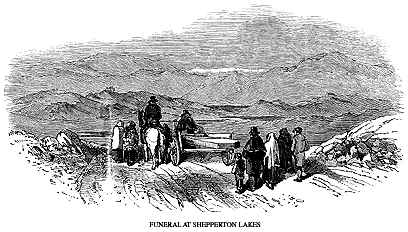 "After leaving Clonakilty,
each step that we took westward brought fresh evidence of the truth of the
reports of the misery, as we either met a funeral or a coffin at every hundred
yards, until we approached the country of the Shepperton Lakes. Here, the
distress became more striking, from the decrease of numbers at the funerals,
none having more than eight or ten attendants, and many only two or three." "After leaving Clonakilty,
each step that we took westward brought fresh evidence of the truth of the
reports of the misery, as we either met a funeral or a coffin at every hundred
yards, until we approached the country of the Shepperton Lakes. Here, the
distress became more striking, from the decrease of numbers at the funerals,
none having more than eight or ten attendants, and many only two or three." |
The Government targeted the Irish landlords as responsible for the Famine. They made them pay rates to support relief. In need of money for their high lifestyle, the landlords exacted the money from the agricultural work force, causing evictions on a large scale. At the same time they were also implementing modern agricultural practices which called for larger farms with fewer people resident and working on the land. Displaced agricultural workers could not find employment in industry which had not developed sufficiently in other areas due to the Irish cultural approach to industrialization, which favored individual isolated workers and small groups over factories and large cooperative concerns.
Universal Potato Crop Failure in July and August lead to the greatest wave of immigration, which generally took place in the summer months. Relief employment was still provided in significant volume to the Irish. In 1846, the following numbers of Irish were employed under this program:
Sep. 30,000 Oct. 150,000 Nov. 285,000 Dec. 500,000
Expenditures to the Irish from the English Board of Works amounted to 30,000 £ sterling a day with an administrative staff of 11,500 persons paid by the English. You can argue "Not enough in retrospect," but nonetheless it was not a small sum for the day. And this under a laissez-faire government. Governments solve problems with paradigms and they tried one they thought would work. We will never know if other tactics could have been seen clearly at the time.
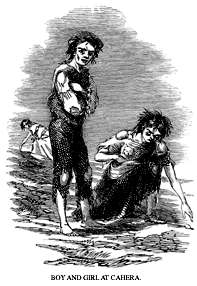 "The first Sketch
is taken on the road, at Cahera, of a famished boy and girl turning up the
ground to seek for a potato to appease their hunger. 'Not far from the spot
where I made this sketch,' says Mr. Mahoney, 'and less than fifty perches
from the high road, is another of the many sepulchres above ground, where
six dead bodies had lain for twelve days, without the least chance of interment,
owing to their being so far from the town.'" "The first Sketch
is taken on the road, at Cahera, of a famished boy and girl turning up the
ground to seek for a potato to appease their hunger. 'Not far from the spot
where I made this sketch,' says Mr. Mahoney, 'and less than fifty perches
from the high road, is another of the many sepulchres above ground, where
six dead bodies had lain for twelve days, without the least chance of interment,
owing to their being so far from the town.'" |
In January 1847, public works were abandoned and direct relief extended. An act was passed providing for the establishment of kitchens and the free distribution of soup. (Alexis Soyer, chef of the London Reform Club, lead an expedition to Ireland to bring modern methods for feeding the poor to their first test in Ireland.) Local fund raising groups were formed in England and all over the world and brought into Ireland. The Quakers formed an especially important relief team. (This local and grassroots effort in England especially has been painfully neglected by historians and those wishing to make political capital from the famine.)
Epidemics of famine fever (typhus) and relapsing fever combined with dysentery, caused by consumption of turnips. Also Indian meal provided by the government did not contain Vitamin C, a fact unknown at the time. Famine dropsy or hunger edema occurred as a result.
In 1847, 100,000 immigrants sailed to the U.S. (often via Canada).
932,000 were maintained on English government relief paid for by taxation of landlords.
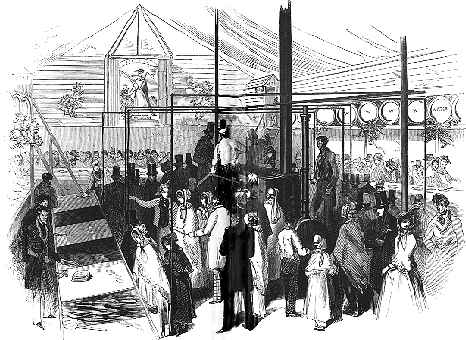 "We learn that the Government
have resolved forthwith to despatch M. Soyer, the chef de cuisine of the
Reform Club, to Ireland, with ample instructions to provide his soups for
the starving millions of Irish people. . . M. Soyer has satisfied the Government
that he can furnish enough and to spare of most nourishing food for the
poor of these realms, and it is confidently anticipated that there will
soon be no more deaths from starvation in Ireland." "We learn that the Government
have resolved forthwith to despatch M. Soyer, the chef de cuisine of the
Reform Club, to Ireland, with ample instructions to provide his soups for
the starving millions of Irish people. . . M. Soyer has satisfied the Government
that he can furnish enough and to spare of most nourishing food for the
poor of these realms, and it is confidently anticipated that there will
soon be no more deaths from starvation in Ireland." |
Population of Ireland was down to 6.5 million. (It had been 8 million in 1841.) Agricultural production had diversified and increased. Farm holdings were larger; a sort of cure, though costly, evolved without government intervention.
No one point of view concerning the Famine can stand on its own. But we can start by gathering as many facts as are available from all sides as well as from some of the corners. The Irish Potato Famine was a multi-dimensional natural/economic/cultural/humanitarian disaster of huge magnitude. At every level there is enough blame to go around. We cannot leave any dimension out when trying to understand the event. The well-intentioned assistance at great political and financial cost to the English people and government must not be obscured by folklore or cumulative hatred. The role of both cultures in tragedy must be fully explored. While the culture of landlordism lacked humanitarianism, the culture of Celtic Ireland greeted potato dependence with open arms and failed to adapt to the new Industrial Age. Thousands left a sinking country to its fate. Foreign countries for which the Irish had fought and died in costly wars of rebellion did not arrive to liberate the people from both England and the Famine when they were needed most. But the greatest tragedy is the death of millions and the continuation of famines today to consume millions of lives unchecked. We cannot let history tell us that the painful fate of so many was somehow inevitable, that they could have done nothing to escape it, because we too are those people. We just happened to survive.
 "At this moment, the funeral
cart with its attendant came towards us; it stopped opposite the cottage;
a deal coffin of a large size, in order to suit the dimensions of all persons,
lay jolting at the top. . . We learnt that the coffin was for a woman who
lay dead in that house, and that four others of the same family lay sick
of the fever, unable even to assist in removing the body of their relation.
The man with the cart called to another [and] both disappeared within the
shadow of the door way. Presently they returned, bearing between them the
dead body, over which a scanty tattered yellow rag had just been thrown,
not sufficient however to cover the whole length of the figure, or to prevent
one's seeing the livid lifeless arms as they hung down swinging and knocking
against the ground. They hastily flung it into the shell, the cart drove
off, and the remains were hurriedly consigned to the earth without a coffin,
and without the offices of religion! " "At this moment, the funeral
cart with its attendant came towards us; it stopped opposite the cottage;
a deal coffin of a large size, in order to suit the dimensions of all persons,
lay jolting at the top. . . We learnt that the coffin was for a woman who
lay dead in that house, and that four others of the same family lay sick
of the fever, unable even to assist in removing the body of their relation.
The man with the cart called to another [and] both disappeared within the
shadow of the door way. Presently they returned, bearing between them the
dead body, over which a scanty tattered yellow rag had just been thrown,
not sufficient however to cover the whole length of the figure, or to prevent
one's seeing the livid lifeless arms as they hung down swinging and knocking
against the ground. They hastily flung it into the shell, the cart drove
off, and the remains were hurriedly consigned to the earth without a coffin,
and without the offices of religion! " |